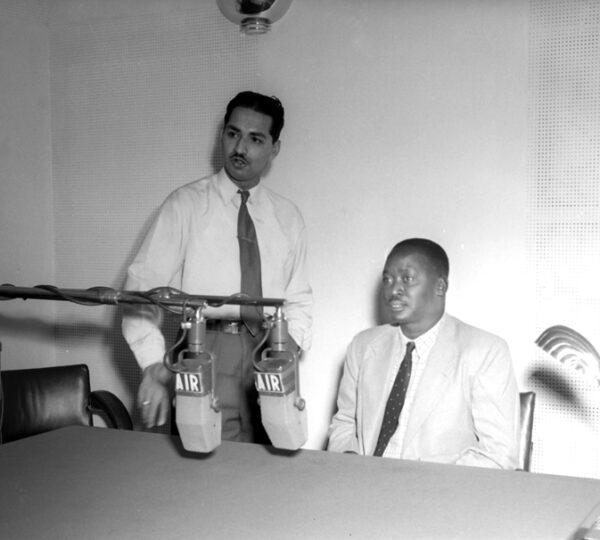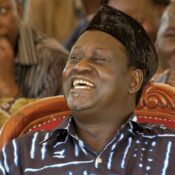Raila Odinga: A Luo Leader’s Journey (Part 1)
The People’s Champion, Father of Democracy
January 7, 1945 – October 15, 2025
It is with profound grief and heavy hearts that the Luo community mourns the passing of our beloved son, Raila Amolo Odinga, affectionately known as “Baba” (Father) to everyone. On October 15, 2025, Kenya lost not just a political leader, but a towering figure whose life embodied the struggles, aspirations, and indomitable spirit of our people.
A Son of Luo
Born at the Anglican Church Missionary Society Hospital in Maseno, Kisumu District, on January 7, 1945, Raila was the son of Jaramogi Oginga Odinga, Kenya’s first Vice President, and Mary Juma Odinga. From his earliest days, he was destined to carry forward a legacy of service, sacrifice, and unwavering commitment to justice.

Studio/Mar.53, A10z
Mr. Oginga Odinga, a distinguished African leader of the Kenya Colony was one on a short visit to India in March 1953, giving a broadcast talk at the New Delhi Station of All India Radio, during his visit to the Station.
Raila’s early years were spent in the heart of Luo country, in Bondo, Siaya County, where he grew up alongside his siblings. As the second-born son of Jaramogi and Mary Ajuma Odinga, Raila was part of a large family that included his older brother Oburu Odinga, and younger siblings: Ngire Omwuoda Agola (born 1947, died 1983), Dr. Akinyi Wenwa, Beryl Achieng, Fredrick Odima (born 1954, died 1975), Master Omondi Oginga (who died in infancy in 1956), Shadrack Osewe (born 1958, died 1999), and the youngest, Ruth Adhiambo Odinga. His older brother Oburu, who was only one year and two months his senior, would later recall that they were raised almost like twins – inseparable companions who shared everything.
The Odinga household was marked by both joy and tragedy. Several of Raila’s siblings died young – Agola at 36, living a private life away from politics; Odima at 21 in what was reported as a suicide; and Osewe, who was a businessman and lived privately until his death in 1999.
Their mother, Mary Ajuma, was a formidable woman who raised her children with both discipline and love, teaching them essential life skills and instilling in them the values of hard work and resilience.
Growing up as the son of Jaramogi Oginga Odinga meant that young Raila witnessed history unfolding in his own home. His father was a key figure in Kenya’s independence struggle, and the Odinga household regularly hosted freedom fighters, political strategists, and visionaries who were charting the course of a new nation. When Jaramogi became Kenya’s first Vice President in 1963, six-year-old Raila saw firsthand what leadership meant. But the lesson that would shape him most came three years later, in 1966, when his father resigned from government over ideological differences with President Jomo Kenyatta. This principled stand against injustice – even at great personal cost – taught young Raila that integrity matters more than power.
Raila’s formal education began at Kisumu Union Primary School, followed by Maranda Primary School and then Maranda High School in Bondo, an institution renowned for producing Luo intellectuals and leaders. Oburu Odinga would later recall his younger brother’s brilliance even in those early school days, describing him as exceptionally sharp and curious. But in 1962, at just 17 years old, Raila made a decision that would broaden his worldview beyond the shores of Lake Victoria: he left secondary school to pursue higher education in East Germany. First enrolling at the Herder Institute in Leipzig to master the German language, then he later attended the Technical University of Magdeburg, where he earned a Master of Science degree in Mechanical Engineering in 1970.
The Revolutionary Spirit
Those years in East Germany during the Cold War exposed Raila to socialist ideology, revolutionary thinking, and a global perspective on liberation struggles. When he returned to Kenya in 1970, he brought back not just an engineering degree, but a deepened commitment to social justice. He briefly lectured at the University of Nairobi and worked at the Kenya Bureau of Standards, but his true calling was becoming clear. The seeds of activism planted in his childhood were beginning to sprout, and the political arena was calling him home. His political awakening came in the crucible of Kenya’s struggle against autocracy, and he never wavered from that path.
The Odinga Lineage: Luo Roots, Not Wanga
In later years, particularly during political campaigns in Western Kenya, Raila would occasionally claim descent from the Wanga Kingdom, even stating in October 2019 that he was “the 13th descendant of Nabongo Wanga” and a grandchild of the famous King Nabongo Mumia. This claim was clearly a political strategy to deepen his bond with the Luhya community and expand his support base beyond Nyanza.
However, this claim does not hold up under genealogical scrutiny. In his 1967 autobiography “Not Yet Uhuru,” Jaramogi Oginga Odinga meticulously documented the family’s lineage, which is rooted firmly in the Luo community of Bondo, with no direct blood connection to the Wanga Kingdom. The documented Odinga lineage, as recorded by Jaramogi himself, traces as follows:
Odinga Rayila (Jaramogi’s father, after whom Raila was named. Born: circa 1870s-1880s (estimated)) + Mama Opondo Nyamagolo (Jaramogi’s mother)
↓
Jaramogi Oginga Odinga (born Obadiah Adonijah in October 1911, later known as Ker of the Luo people) + Mary Juma Odinga (Jaramogi’s first wife, born July 1924 in Alego, Siaya County)
↓
Raila Amolo Odinga (born January 7, 1945)
There were also rumors of a curse placed on Jaramogi’s grandfather for allegedly leading a failed palace coup while serving as aide-de-camp of Nabongo Mumia in the 1890s. However, a fact-check against Jaramogi’s own genealogical records in “Not Yet Uhuru” shows this story holds little water. This story is demonstrably false on multiple grounds.
First, Jaramogi’s own account in “Not Yet Uhuru” directly contradicts it. He speaks of his grandfather Rayila (after whom Raila was named) as being rather indigent and unable to even raise dowry for a wife, being forced to marry a widow. Jaramogi describes his family lineage as long established in Luo Nyanza, in Bondo, Siaya, far away from Mumias where the Wanga Kingdom was based.
Second, the timeline and geography make this story impossible. Odinga Rayila was born in the 1870s-1880s in Bondo, deep in Luo territory, which is geographically and culturally distant from Mumias, the seat of the Wanga Kingdom. Nabongo Mumia reigned from approximately 1882 through 1949 – spanning Rayila’s lifetime. Yet in “Not Yet Uhuru,” written in the 1960s, Jaramogi makes no mention whatsoever of his father or grandfather serving in Mumia’s court. Such a connection, if it existed, would have been a matter of considerable pride and historical significance, particularly given the political importance of building bridges with the Luhya community. Jaramogi’s complete silence on this matter, in an autobiography that meticulously documents his family’s history and political struggles, is itself powerful evidence that no such connection ever existed.
This curse story is pure political mythology invented to explain Raila’s five electoral losses by attributing them to supernatural causes rather than the systemic electoral manipulation, political machinations, and violence that actually characterized Kenya’s elections. The Odinga lineage is rooted in the political activism and leadership of the Luo community, while Mumia’s legacy is anchored in the historical significance of the Wanga Kingdom – two distinct and separate lineages with no documented connection.
Significantly, Professor Bethwell Allan Ogot, Kenya’s most distinguished historian and the preeminent authority on Luo history, never documented any Odinga-Wanga lineage connection in any of his extensive works, despite his exhaustive research on Luo clans and their interactions with neighboring communities. Ogot’s monumental works, including “History of the Southern Luo” (1967) and “A History of the Luo-Speaking Peoples of East Africa” (2009), meticulously documented Luo genealogies, migrations, and intermarriages with neighboring peoples including the Luhya. If a genuine blood relationship existed between the Odinga family and the Wanga Kingdom, Ogot – who interviewed hundreds of elders and was politically close to the Odinga family – would have certainly documented it. His silence on this matter is itself telling.
While Raila’s claim to Wanga ancestry was mere political expediency that helped him build bridges with Western Kenya voters, the truth remains that he was, first and foremost, a son of the Luo nation descended from a line of leaders who earned their authority through service, sacrifice, and the people’s trust, not through royal bloodlines.
Published by the Luo National Congress
October 17, 2025



9 thoughts on “Raila Odinga: A Luo Leader’s Journey (Part 1)”
Very touching autobiography and encouraging for our luos new blood.
May his soul rise with the dusts of the Luo’s soil to our creaors-ancestors.
Amen!
Thanks for this elaborate piece. A lot of new information in it🙏🏻
Thank you Opwonya
Raila’s brother Agola (Omuoda) died from health complications after being badly treated while detained for being involved in a road accident. he was diabetic, and was denied/blocked from his medication while in custody, and was taken to Kakamega Hospital chained to the bed by prison officers where his health deteriorated. He died soon after.
Thank you for the clarification. We will make sure to add this to the post
Thanks for the elaboration🙏.
Thank you, Johnson
This is very elaborate information about the son of Luo Raila Amollo Odinga